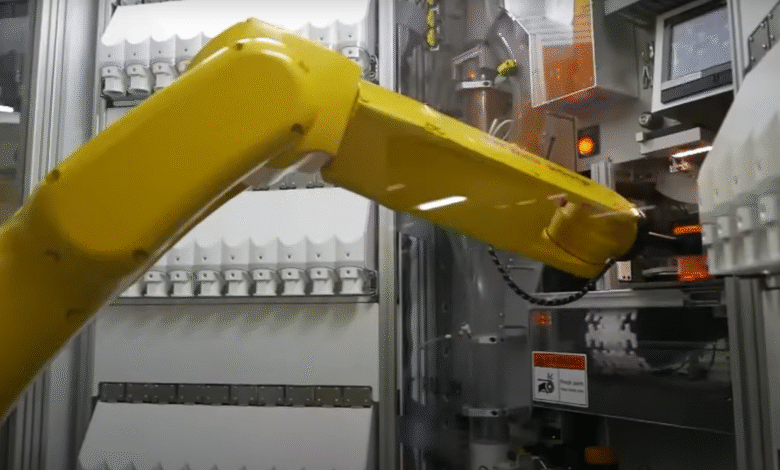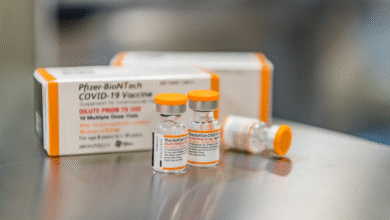Walgreens Prescription-Filling Robots Transform Pharmacists’ Work

Walgreens prescription-filling robots are revolutionizing the way pharmacies operate, offering a cutting-edge solution to the rising demands of pharmacy technology. By employing robotic prescription filling systems within their micro-fulfillment centers, Walgreens aims to enhance efficiency while simultaneously reducing costs for their operations. This innovative approach not only alleviates the workload on pharmacists but also allows staff to focus more on patient interactions and clinical services. As the retail pharmacy landscape becomes increasingly competitive, Walgreens automation initiatives represent a strategic shift designed to streamline processes and improve operational efficiency. Ultimately, these robotic systems are not just about technology; they symbolize a commitment to better patient care and significant cost reduction in pharmacies.
In a rapidly evolving healthcare environment, Walgreens is leveraging advanced systems to optimize medication dispensing through robotic assistance. These automated solutions, situated within micro-fulfillment centers, are enhancing pharmacy efficiency by allowing for faster and more accurate prescription filling. This shift towards automation in pharmaceutical services aligns with a broader trend of incorporating cutting-edge technology to enhance patient care and reduce operational costs. By integrating these robotic systems, Walgreens is not only improving service delivery but also addressing workforce challenges through strategic automation efforts. This focus on enhancing pharmacy workflows paves the way for a future where healthcare providers can devote more attention to direct patient engagement.
The Role of Walgreens Prescription-Filling Robots in Pharmacy Automation
Walgreens has been pioneering the integration of prescription-filling robots as part of its broader commitment to pharmacy automation. These robotic systems are not merely technological novelties; they represent a significant shift in how prescriptions are processed across thousands of locations. By harnessing the power of robotic automation, Walgreens aims to increase operational efficiency and enhance the overall patient experience. This automation facilitates quicker turnaround times for prescription filling, ensuring that patients receive their medications promptly, especially for chronic conditions like diabetes and hypertension.
In addition to speeding up the prescription process, Walgreens prescription-filling robots also contribute to cost reduction in pharmacies. Automated systems minimize the potential for human error, leading to a reduction in prescription inaccuracies and improving safety for patients. As labor costs rise and pharmacies face increasing operational expenses, these robots offer a scalable solution that allows Walgreens to streamline its workflow. Moreover, the deployment of robots allows human pharmacists to focus on more complex patient interactions, providing consultations and overseeing clinical services, which is vital for improving patient outcomes.
Enhancing Efficiency Through Micro-Fulfillment Centers
Micro-fulfillment centers serve as the backbone of Walgreens’ automation strategy, enabling the company to fill prescriptions more efficiently. Developed in response to evolving market demands and feedback from pharmacy staff, these centers employ sophisticated robotics and automated processes to quickly manage prescription orders. By routing maintenance medications and refills to these facilities, Walgreens can handle a significantly higher volume of prescriptions in a shorter amount of time, thereby improving service delivery to customers and granting pharmacy staff more time for direct patient engagement.
The strategic expansion of these micro-fulfillment centers is designed to optimize operations while reducing excess inventory costs. Since launching these centers, Walgreens has reported significant savings, amounting to hundreds of millions of dollars. By improving efficiency and effectively managing resources, Walgreens can reduce waste, which ultimately leads to cost reduction in pharmacies. As Walgreens continues to innovate with advanced automation technology, a stronger focus on patient care and operational excellence remains paramount.
Advantages of Walgreens Automation in Pharmacy Operations
The incorporation of automation and robotic systems within Walgreens’ pharmacy operations has yielded notable advantages. Firstly, these advanced technologies allow pharmacy staff to redirect their focus from mundane tasks to crucial patient services. This shift not only enhances job satisfaction for employees but also elevates the quality of care patients receive. Pharmacists can engage more thoroughly with patients, addressing medication questions, managing health screenings, and providing important health advice without the pressure of high-volume manual filling tasks.
Additionally, Walgreens automation plays a crucial role in addressing staffing shortages that have plagued the pharmacy industry in recent years. By leveraging robotic prescription filling, Walgreens is tackling the issues caused by workforce burnout and turnover. As pharmacies compete for qualified personnel, automation optimizes existing staff efficiency, helping alleviate workload pressures and enhancing employee well-being. This strategic approach allows for the delivery of higher standards of care and fosters a more supportive work environment for pharmacy professionals.
The Future of Pharmacy Technology at Walgreens
Looking ahead, Walgreens is fully committed to transforming pharmacy technology through innovations like robotic prescription filling and micro-fulfillment centers. The company’s recent advancements signal a proactive approach to embracing change and utilizing technology to enhance operational efficiency. As intern processes evolve, Walgreens is integrating real-time tracking systems that provide insights into prescription statuses, further streamlining patient interactions and improving service quality.
Moreover, Walgreens’ investment in pharmacy technology extends beyond automation. The company is also focusing on enhancing its digital platforms to ensure that patients have seamless access to their prescriptions. By bridging the gap between technology and patient care, Walgreens is setting a precedent for how pharmacies can remain relevant in an ever-changing healthcare landscape. Leveraging cutting-edge pharmacy technology fulfills both operational demands and customer expectations, positioning Walgreens for a future where speed, accuracy, and care are paramount.
Impact of Automation on Patient Care at Walgreens
The impact of Walgreens’ automation initiatives extends beyond operational benefits to significantly influence patient care. By utilizing robotic systems to handle routine prescription filling, pharmacists are granted more time to interact directly with patients, which is critical in a healthcare environment that increasingly prioritizes personalized care. This direct engagement allows pharmacists to provide tailored advice and necessary health checks, contributing to better health outcomes and patient satisfaction.
Furthermore, automation has enabled Walgreens to expand its clinical services, such as administering vaccinations and conducting health screenings. Pharmacists empowered by robotic assistance can focus on assessing patient needs and facilitating necessary interventions without feeling overwhelmed by the demands of prescription management. As a result, Walgreens is not only improving its efficiency but is fostering a healthcare model that is more responsive to the complexities of patient care.
Challenges and Risks of Robotic Prescription Filling
While the integration of robotic prescription filling heralds numerous benefits, it also presents challenges and risks that Walgreens must navigate. One major concern is the potential for technological failures during operations, which can lead to disruptions in service delivery. If a robotic system malfunctions or makes an error, it could significantly impact patient trust and safety. Therefore, it’s essential for Walgreens to invest in maintenance, training, and quality assurance protocols that can effectively mitigate these risks.
Additionally, as Walgreens embraces automation, it must also consider the workforce implications of transitioning to a more robotic-centric operation. While automation creates efficiencies, it can potentially lead to job displacement for some pharmacy employees. Navigating the balance between automation and maintaining skilled roles within the workforce will be crucial for Walgreens as it aims to create a sustainable model that prioritizes both efficiency and employee engagement.
Cost Reduction Strategies Through Robotic Automation
Cost reduction in pharmacies is essential for maintaining profitability in the current healthcare landscape, and Walgreens is capitalizing on robotic automation to achieve this goal. Through its micro-fulfillment centers, Walgreens has already realized substantial cost savings, projected at approximately $500 million as a result of streamlined operations and reduced inventory waste. This economic advantage positions Walgreens as a competitive player in the pharmacy market, especially as they navigate the complexities of reimbursement rates and rising operational expenses.
Moreover, the enhanced efficiency that comes from automating prescription filling allows Walgreens to allocate resources more effectively. By supporting pharmacy staff with advanced technology, Walgreens can minimize the time spent on labor-intensive tasks, reduce turnover rates, and ultimately enhance the bottom line. The company’s ongoing commitment to innovation in pharmacy technology will likely yield additional cost reduction opportunities and help navigate the evolving marketplace.
The Role of Patient Feedback in Walgreens’ Automation Efforts
Patient feedback plays an essential role in shaping Walgreens’ approach to automation within medication management systems. Engaging with patients allows Walgreens to refine its processes and enhance service delivery based on real-world experiences and expectations. The incorporation of patient insights into the automation strategy ensures continuous improvement, which is crucial to the long-term success of robotic prescription filling solutions.
As Walgreens implements changes based on patient feedback, it demonstrates a commitment to patient-centered care. This feedback loop fosters a more responsive environment where services are tailored to meet the needs and preferences of patients. By prioritizing the voices of those they serve, Walgreens ensures that the shift towards automation ultimately leads to improved patient experiences and health outcomes.
Walgreens’ Competitive Edge in Pharmacy Automation
In a competitive landscape crowded with pharmacy chains and retail giants, Walgreens is leveraging automation to create a competitive edge. The reliance on micro-fulfillment centers and robotic prescription filling not only sets Walgreens apart from traditional competitors but also allows them to adapt more quickly to market shifts. Building on this technological foundation, Walgreens can offer faster and more reliable service, a necessity in a consumer-driven healthcare environment.
Furthermore, the focus on automation provides Walgreens with strategic benefits that independent pharmacies and some competitors may struggle to match. With centralized support from robotic systems, Walgreens can achieve efficiencies that enhance profitability while reducing costs for consumers. As the healthcare landscape continues to evolve, Walgreens’ commitment to automation positions the company well for sustained growth and relevance in the future.
Frequently Asked Questions
What are Walgreens prescription-filling robots and how do they work?
Walgreens prescription-filling robots are part of the pharmacy automation system utilized in micro-fulfillment centers. They process thousands of prescriptions for patients with chronic conditions by using robotics, conveyor belts, and barcode scanning technologies. When a prescription is received, the system determines whether it will be filled onsite or at a micro-fulfillment center, where robotic arms efficiently dispense medication into prescription vials. This advanced pharmacy technology streamlines operations, reduces manual labor, and enhances patient safety.
How have Walgreens prescription-filling robots impacted pharmacy cost reduction?
Walgreens prescription-filling robots have contributed significantly to cost reduction in pharmacies by automating the prescription filling process. Reports indicate that these micro-fulfillment centers have achieved approximately $500 million in savings by minimizing excess inventory and improving operational efficiency. Furthermore, the automation has led to a 13% decrease in total prescription fulfillment costs compared to the previous year, enabling Walgreens to allocate more resources towards patient care and clinical services.
What are the benefits of Walgreens automation in pharmacy services?
Walgreens automation in pharmacy services, particularly through the use of prescription-filling robots, benefits both customers and pharmacy staff. The automation allows pharmacists to spend more time interacting with patients, providing personalized care, and administering clinical services like vaccinations. It also reduces the routine workload on pharmacy staff, alleviating stress and burnout, while enabling the efficient processing of prescriptions, ultimately leading to better patient outcomes.
What role do micro-fulfillment centers play in Walgreens’ pharmacy technology strategy?
Micro-fulfillment centers are central to Walgreens’ pharmacy technology strategy, utilizing robots to manage a significant volume of prescription filling. By enhancing the operational capacity of these centers, Walgreens can support more retail locations and implement advanced robotic systems for efficient prescription processing. This approach not only streamlines operations but also allows Walgreens to maintain a competitive edge over other pharmacy chains by improving service delivery and reducing costs.
Are Walgreens prescription-filling robots effective in managing pharmacist workloads?
Yes, Walgreens prescription-filling robots are effective in managing pharmacist workloads. By automating the prescription fulfillment process, these robots assist pharmacy staff in minimizing repetitive tasks, allowing them to focus on patient engagement and healthcare services. This shift has been shown to increase operational productivity, with pharmacists reporting more time available for direct patient care, which can significantly enhance the overall quality of pharmacy services.
How does Walgreens enhance its robotic prescription filling technology?
Walgreens continues to enhance its robotic prescription filling technology based on feedback and performance metrics. Updates include the introduction of new roles to support automation processes and adjustments to packaging, such as transitioning to smaller prescription vials to optimize shipping efficiency. These improvements are aimed at further boosting operational accuracy, efficiency, and patient safety, ensuring that the robotic systems work effectively to meet pharmacy demands.
What challenges do Walgreens’ prescription-filling robots face?
Challenges faced by Walgreens’ prescription-filling robots include the reliance on advanced robotics, which can lead to operational disruptions if errors occur. Additionally, there are concerns regarding accuracy in medication dispensing and the need for adequate staff training to ensure patient safety. Walgreens is actively working to address these issues to enhance the reliability and efficiency of their micro-fulfillment centers.
How are Walgreens prescription-filling robots contributing to patient care?
Walgreens prescription-filling robots contribute to patient care by freeing up pharmacists to engage more directly with patients. This increased availability allows pharmacy staff to conduct health assessments, administer vaccines, and provide personalized advice, significantly improving the patient experience and overall healthcare outcomes. By automating routine tasks, these robots enhance the capacity of pharmacies to offer comprehensive clinical services.
What future developments can we expect with Walgreens prescription-filling automation?
Future developments in Walgreens prescription-filling automation may include the potential for direct shipment of prescriptions to patients’ homes, relieving retail stores of that responsibility. Ongoing upgrades to robotic systems and micro-fulfillment technologies are anticipated, as well as further integration of real-time tracking tools to improve prescription status visibility. These advancements aim to refine the automation process, ensuring that Walgreens remains at the forefront of pharmacy technology.
| Key Points |
|---|
| Walgreens is increasing the number of micro-fulfillment centers to streamline prescription processing and free up pharmacists for patient interaction. |
| These centers utilize robotics to handle up to 40% of prescription volumes, enhancing efficiency and reducing costs. |
| Since the introduction of micro-fulfillment centers, Walgreens has reported savings of around $500 million due to reduced inventory waste and improved efficiency. |
| Walgreens aims to expand its micro-fulfillment capabilities to service over 5,000 stores by the end of the year. |
| Pharmacy staff at stores utilizing these centers can provide 40% more vaccines than those that do not. |
| Improvements are based on feedback, with new roles created to enhance training and efficiency at the micro-fulfillment centers. |
| While the centers are yielding positive results, further development is necessary for optimal functionality. |
Summary
Walgreens prescription-filling robots are transforming the pharmacy landscape by enhancing efficiency and allowing pharmacists to focus more on patient care. With the expansion of micro-fulfillment centers, Walgreens is not only streamlining prescription processing but also reducing operational costs significantly. By automating routine tasks, the company empowers pharmacy staff to engage directly with patients, facilitating better healthcare services such as vaccinations and health assessments. This technological advancement highlights Walgreens’ commitment to improving pharmacy operations, meeting the evolving needs of healthcare management, and staying competitive in an increasingly digital retail environment.




